| Revision as of 16:40, 3 February 2014 view sourceEvergreenFir (talk | contribs)Autopatrolled, Administrators129,854 editsm Reverted 1 edit by Wester (talk) to last revision by Materialscientist. (TW)← Previous edit | Revision as of 18:13, 3 February 2014 view source Wester (talk | contribs)Extended confirmed users4,773 editsNo edit summaryNext edit → | ||
| Line 6: | Line 6: | ||
| | caption = A dish of French fries | | caption = A dish of French fries | ||
| | alternate_name = Chips, hot chips, finger chips, fries, steak fries, wedges, potato wedges, frites | | alternate_name = Chips, hot chips, finger chips, fries, steak fries, wedges, potato wedges, frites | ||
| | country = ] or ] | |||
| | region = | | region = | ||
| | creator = | | creator = | ||
Revision as of 18:13, 3 February 2014
 A dish of French fries A dish of French fries | |
| Alternative names | Chips, hot chips, finger chips, fries, steak fries, wedges, potato wedges, frites |
|---|---|
| Course | Side dish or snack, rarely as a main dish |
| Serving temperature | Hot, generally salted, often served with ketchup, vinegar, barbecue sauce, mayonnaise, or other sauce on the side |
| Main ingredients | Potatoes and oil |
French fries (American English) or chips, fries, finger chips, or French-fried potatoes are batons of deep-fried potato. Americans and most Canadians refer to any elongated pieces of fried potatoes as fries, while in the United Kingdom, Australia, Ireland and New Zealand, long, thinly cut slices of fried potatoes are sometimes called fries to distinguish them from the more thickly cut strips called chips.
French fries are served hot and generally eaten as an accompaniment with lunch or dinner, or eaten as a snack, and they are a common fixture of fast food. French fries are generally salted and, in their simplest and most common form, are served with ketchup; in many countries, though, they are topped instead with other condiments or toppings, including vinegar, mayonnaise, or other local specialities. Fries can also be topped more elaborately, as is the case with the dishes of poutine and chili cheese fries. Sometimes, fries are made with sweet potatoes instead of potatoes, are baked instead of fried, or are cut into unusual shapes, as is the case with curly fries, wavy fries, or tornado fries.
Etymology
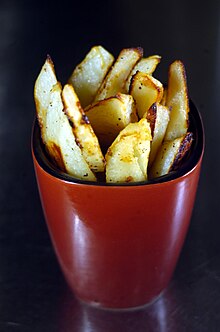
Thomas Jefferson had "potatoes served in the French manner" at a White House dinner in 1802.
The expression "French Fried Potatoes" first occurs in print in English in the 1856 work Cookery for Maids of All Work by E Warren:
"French Fried Potatoes. – Cut new potatoes in thin slices, put them in boiling fat, and a little salt; fry both sides of a light golden brown colour; drain."
In the early 20th century, the term "French fried" was being used in the sense of "deep-fried", for other foods such as onion rings or chicken.
It is unlikely that "French fried" refers to frenching in the sense of julienning, which is not attested until after French fried potatoes. Previously, Frenching referred only to trimming meat off the shanks of chops.
Culinary origin
Belgium
It is claimed that fries originated in Belgium, and the on-going dispute between the French and Belgians about where they were invented is highly contentious, with both countries claiming ownership. The popularity of the term "French fries" is explained as a result of "French gastronomic hegemony" internationally, where the cuisine of Belgium was assimilated because of a lack of understanding.
Belgian journalist Jo Gérard claims that a 1781 family manuscript recounts that potatoes were deep-fried prior to 1680 in what was then the Spanish Netherlands (present-day Belgium), in the Meuse valley: "The inhabitants of Namur, Andenne, and Dinant, had the custom of fishing in the Meuse for small fish and frying, especially among the poor, but when the river was frozen and fishing became hazardous, they cut potatoes in the form of small fish and put them in a fryer like those here." Gérard has not produced the manuscript that supports this claim, which, even if true, is unrelated to the later history of the French fry, as the potato did not arrive in the region until around 1735. Also, given 18th century economic conditions: "It is absolutely unthinkable that a peasant could have consecrated large quantities of fat for cooking potatoes. At most they were sautéed in a pan...".
Some people believe that the term "French" was introduced when British and American soldiers arrived in Belgium during World War I and consequently tasted Belgian fries. They supposedly called them "French", as it was the local language and official language of the Belgian Army at that time, believing themselves to be in France. At this time, the term "French fries" was growing popular; however, in the south of Netherlands, bordering Belgium, they were, and still are, called Vlaamse frieten ("Flemish fries").
"Pommes frites", "frites" (French), or "frieten" (Dutch) became the national snack and a substantial part of several national dishes, such as Moules-frites or Steak-frites.
France and other French-speaking countries

In France and other French-speaking countries, fried potatoes are formally pommes de terre frites, but more commonly pommes frites, patates frites, or simply frites. The word "aiguillettes" or allumettes is used when the chips are very small and thin.
Eating potatoes was promoted in France by Parmentier, but he did not mention fried potatoes in particular. Many Americans attribute the dish to France and offer as evidence a notation by U.S. President Thomas Jefferson. "Pommes de terre frites à cru, en petites tranches" ("Potatoes deep-fried while raw, in small cuttings") in a manuscript in Thomas Jefferson's hand (circa 1801–1809) and the recipe almost certainly comes from his French chef, Honoré Julien. In addition, from 1813 on, recipes for what can be described as French fries occur in popular American cookbooks. By the late 1850s, one of these uses the term French fried potatoes.
Frites are the main ingredient in the Canadian dish of Québécois descent known in both Canadian English and French as poutine, consisting of fried potatoes covered with cheese curds and gravy, a dish with a growing number of variations.
Spain
In Spain, fried potatoes are called patatas fritas or papas fritas. Another common form, in which the potatoes are cut into irregular shapes and seasoned with a spicy tomato sauce, is called patatas bravas.
Some speculate that the dish may have been invented in Spain, the first European country in which the potato appeared via the New World colonies, and assumes the first appearance to have been as an accompaniment to fish dishes in Galicia, from which it spread to the rest of the country and further to the Spanish Netherlands, which became Belgium more than a century later.
Professor Paul Ilegems, curator of the Frietmuseum in Bruges, Belgium, believes that Saint Teresa of Ávila fried the first chips, referring also to the tradition of frying in Mediterranean cuisine.
Spreading popularity
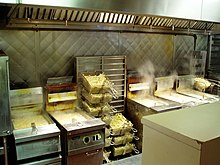
Frozen fries
The J. R. Simplot Company is credited with successfully commercializing French fries in frozen form during the 1940s. Subsequently, in 1967, Ray Kroc of McDonald's contracted the Simplot company to supply them with frozen fries, replacing fresh-cut potatoes.
In 2004, 29% of the United States' potato crop were used to make frozen fries – 90% consumed by the food services sector and 10% by retail. It is estimated that 80% of households in the UK buy frozen fries each year.
Canada's McCain Foods is the world's leading producer of frozen fries.
Belgium and the Netherlands

Fries are very popular in Belgium, where they are known as friet or frites, and the Netherlands, where they are known as patat and, in the south, friet. In Belgium, fries are sold in shops called friteries (French), frietkot/fritkot/frituur (Dutch), or Fritüre/Frittüre (German). They are served with a large variety of Belgian sauces and eaten either on their own or with other snacks such as fricandelle or burgers. Traditionally, fries are served in a cornet de frites (French), frietzak/fritzak (Dutch), or Frittentüte (German), a white cardboard cone, then wrapped in paper, with a spoonful of sauce on top. They may also be served with other traditional fast-food items, such as frikandel/fricadelle, gehaktbal/boulet (meatballs) or kroket/croquette. In the Netherlands, fries are sold at snack bars, often served with mayonnaise or curry ketchup.
Friteries and other fast-food establishments tend to offer a number of different sauces for the fries and meats. In addition to ketchup and mayonnaise, popular options include:
- Aioli, garlic mayonnaise.
- Sauce Andalouse – mayonnaise with tomato paste and peppers.
- Sauce Americaine – mayonnaise with tomato chervil onions, capers and celery.
- Bicky Dressing (Gele Bicky-sauce), a commercial brand made from mayonnaise, white cabbage, tarragon, cucumber, onion, mustard and dextrose.
- Curry mayonnaise.
- Mammoet-sauce – mayonnaise, tomato, onion, glucose, garlic, soy sauce.
- Peanut sauce – when combined with mayonnaise and optionally raw onion, this is called patat oorlog ("war fries").
- Samurai-sauce – mayonnaise with sambal oelek.
- Sauce "Pickles" – a yellow mayonnaise-based sauce with turmeric, mustard and crunchy vegetable chunks, similar to Piccalilli.
- Pepper-sauce – mayonnaise with green pepper, garlic, glucose.
- Tartar sauce.
- Zigeuner sauce, a "gypsy" sauce of tomatoes, paprika and chopped bell peppers, borrowed from Germany.
These sauces are generally also available in supermarkets. In addition to this, hot sauces are sometimes offered by friteries, including hollandaise sauce, sauce provençale, Béarnaise sauce, or a splash carbonade flamande stew from an constantly simmering pot, in the spirit of British chips and gravy.
United Kingdom
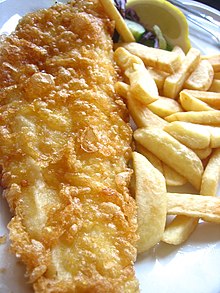
Traditionally, chips in the United Kingdom are cut much thicker and are typically between 10 and 15 mm (3/8–1/2 inches) wide. Since the surface-to-volume ratio is lower, they have a lower fat content. Thick-cut, or beefsteak, British chips are occasionally made from unpeeled potatoes. Chips are not necessarily served as crisp as the continental European French fry due to their relatively high water content.
As with all members of the deep-fried chip family, they are cooked twice, once at a relatively low temperature (blanching) to cook the potato, and then at a higher temperature to crisp the surface, making them crunchy on the outside and fluffier on the inside.
In the UK, chips are part of the popular take-away dish fish and chips.
The first chips fried in the UK were on the site of Oldham's Tommyfield Market in 1860. A blue plaque in Oldham marks the origin of the fish and chip shop and fast food industries in Britain. In Scotland, chips were first sold in Dundee, "...in the 1870s, that glory of British gastronomy – the chip – was first sold by Belgian immigrant Edward De Gernier in the city's Greenmarket".
United States

Although chips were already a popular dish in most Commonwealth countries, the thin style of French fries has been popularized worldwide in part by the large American fast-food chains such as McDonald's, Burger King, Wendy's, and Arby's.
Pre-made French fries have been available for home cooking since the 1960s, usually having been pre-fried (or sometimes baked), frozen and placed in a sealed plastic bag.
Some later varieties of French fries are battered and breaded, and many fast-food chains in the U.S. dust the potatoes with kashi, dextrin, and other flavor coatings for crispier fries with particular tastes. Results with batterings and breadings, followed by microwaving, have not achieved widespread critical acceptance. Oven frying delivers a dish different from deep-fried potatoes.
Variants

Variants of French fries include thick-cut fries, steak fries, shoestring fries, jojos, crinkle fries, curly fries, hand-cut fries and tornado fries. Fries cut into rough cubes instead of sticks are called home fries. Fries cut thickly with the skin left on are called potato wedges, and fries without the skin are called steak fries, essentially the American equivalent of the British chip. They can also be coated with breading, spices, or other ingredients, which include garlic powder, onion powder, black pepper, paprika, and salt to create seasoned fries, cheese to create cheese fries, or chili to create chili fries. Sometimes, French fries are cooked in the oven as a final step in the preparation (having been coated with oil during preparation at the factory): these are often sold frozen and are called oven fries or oven chips. Some restaurants and groceries in North America offer French fries made from sweet potatoes instead of traditional white potatoes.

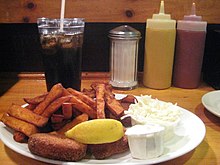
In France, the thick-cut fries are called Pommes Pont-Neuf or simply pommes frites, about 10 mm; thinner variants are pommes allumettes (matchstick potatoes), ±7 mm, and pommes paille (potato straws), 3–4 mm (roughly ⅜, ¼ and ⅛ inch respectively). The two-bath technique is standard (Bocuse). Pommes gaufrettes or waffle fries are not typical French fried potatoes, but actually crisps obtained by quarter-turning the potato before each next slide over a grater and deep-frying just once. This results in large flat fries with two layers, each of which consists of parallel strips of potato.

In an interview, Burger King president Donald Smith said that his chain's fries are sprayed with a sugar solution shortly before being packaged and shipped to individual outlets. The sugar caramelizes in the cooking fat, producing the golden color customers expect. McDonald's was assumed to fry their fries for a total time of about 15 to 20 minutes, and with fries fried at least twice.
Curly fries
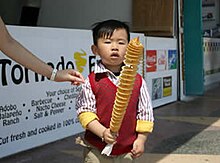
Curly fries are characterized by their spring-like shape. They are generally made from whole potatoes that are cut using a specialized spiral slicer. They are also typically characterized by the presence of additional seasonings (which give the fries a more orange appearance when compared to the more yellow appearance of standard fries), although this is not always the case. This seasoning also gives the fries a slightly spicier taste than standard fries.
Sometimes they are packaged for preparation at home, often in frozen packs. In the US they can also be found at a number of restaurants and fast food outlets like Arby's, Hooters, Hardee's and Jack In The Box, where they are served with condiments such as ketchup, cheese, fry sauce, or sweet chili sauce and sour cream.
Tornado fries
Tornado fries are made by skewering the whole potato, and then cutting with a specialized spiral slicer. The potato is spread evenly along the skewer and deep fried. The cooking process fuses the potato to the skewer and holds it in place. It is then sprinkled with dry seasonings or served with dipping sauce. Tornado fries gets their name from the tornado-like shape that the potato has on the skewer.
Accompaniments
Main article: List of accompaniments to french friesFries tend to be served with a variety of accompaniments, such as salt and vinegar (malt, balsamic or white), pepper, grated cheese, melted cheese, mushy peas, heated curry sauce, curry ketchup (mildly spiced mix of the former), hot or chili sauce, mustard, mayonnaise, bearnaise sauce, tartar sauce, tzatziki, feta cheese, garlic sauce, fry sauce, ranch dressing, barbecue sauce, gravy, aioli, brown sauce, ketchup, lemon juice, piccalilli, pickled cucumber, pickled gherkins, pickled onions or pickled eggs.
Health aspects

French fries contain primarily carbohydrates from the potato (mostly in the form of starch) and fat absorbed during the frying process. For example: A large serving of French fries at McDonald's in the United States is 5.4 ounces (154 grams); nearly all of the 500 calories per serving derive from the 63 g of carbohydrates and the 25 g of fat; a serving also contains 6 g of protein, plus 350 mg of sodium.
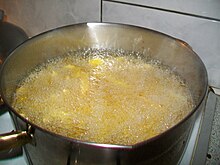
Frying French fries in beef tallow, lard, or other animal fats adds saturated fat to the diet. Replacing animal fats with tropical vegetable oils, such as palm oil, simply substitutes one saturated fat for another. Replacing animal fats with partially hydrogenated oil reduces cholesterol but adds trans fat, which has been shown to both raise LDL cholesterol and lower HDL cholesterol. Canola/Rapeseed oil, or sunflower-seed oil are also used, as are mixes of vegetable oils, but beef tallow is generally more popular, especially amongst fast-food outlets that use communal oil baths. Accordingly, many restaurants now advertise their use of unsaturated oils; for example, both Five Guys and Chick-fil-A advertise that their fries are prepared with peanut oil, while In-N-Out advertises that their fries are prepared with vegetable oil.
A 13-year-long observation performed by the University of Maastricht, the Netherlands, on 120,000 subjects between 55 and 70, has shown that increased intake of acrylamide (formed when starches are cooked at high temperatures) is correlated with a 60% higher rate of kidney cancer. However, researchers from the Harvard School of Public Health and Karolinska Institutet in Stockholm, Sweden, found no association between the consumption of foods high in acrylamide and increased risk of three forms of cancer: bladder, large bowel and kidney.
Legal issues
In June 2004, the United States Department of Agriculture, with the advisement of a federal district judge from Beaumont, Texas, classified batter-coated French fries as a vegetable under the Perishable Agricultural Commodities Act. This was primarily for trade reasons. French fries do not meet the standard to be listed as a processed food. This classification, referred to as the "French fry rule", was upheld in the United States Court of Appeals for the Fifth Circuit case Fleming Companies, Inc. v. USDA.
In the United States in 2002, the McDonald's Corporation agreed to donate $10 million to Hindu and other groups to settle lawsuits filed against the chain for mislabeling French fries and hash browns as vegetarian, because their French fries and hash browns were found to contain beef extract added during production.
See also
- Carne asada fries
- Chip pan
- Deep fryer
- Deep frying
- Freedom fries
- Frietmuseum
- Home fries
- Mitraillette
- Pommes dauphine
- Pommes duchesse
- Pommes soufflées
- Potato wedges
- Poutine
- Tater Tots
- Vacuum fryer
- Waffle fries
References
- Notes
- "chip: definition of chip in Oxford dictionary (British & World English)". Oxforddictionaries.com. 2013-09-12. Retrieved 2013-09-16.
- "The American Heritage Dictionary, Fourth Edition, 2000". Bartleby.com. Retrieved 2009-05-07.
- Indian English, "finger chip". Cambridge Dictionary Online.
- "french fry – Definition". Food & Culture Encyclopedia. Retrieved 2009-12-05.
- Halliburton, Rachel; Muir, Jenni (2008). "London's best chips". Time Out London. p. 2. Retrieved 2008-05-14.
- ^ Ebeling, Charles (2005-10-31). "French fried: From Monticello to the Moon, A Social, Political and Cultural Appreciation of the French Fry". The Chicago Literary Club. Retrieved 12 January 2007.
- Fishwick, Marshall W (1998) . "The Savant as Gourmet". The Journal of Popular Culture. 32 (part 1). Oxford: Blackwell Publishing: 51–58. doi:10.1111/j.0022-3840.1998.3201_51.x.
- Home : Oxford English Dictionary. Oed.com. Retrieved on 2012-09-12.
-
Mackenzie, Catherine (7 April 1935). "Food the City Likes Best". The New York Times Magazine: SM18. Retrieved 2007-04-15.
... the chef at the Rainbow Room launches into a description of his special steak, its French-fried onion rings, its button mushrooms ...
-
Rorer, Sarah Tyson (c. 1902). "Page 211". Mrs. Rorer's New Cook Book. Philadelphia: Arnold & Company. p. 211. Retrieved 2007-04-12.
French Fried Chicken
{{cite book}}: External link in|chapterurl=|chapterurl=ignored (|chapter-url=suggested) (help) - Oxford English Dictionary, June 2010
- ^ Schehr, Lawrence R.; Weiss, Allen S. (2001). French Food: On the Table On the Page and in French Culture. Abingdon: Routledge. p. 158. ISBN 0415936284.
- ^ Template:Fr icon Hugues Henry (2001-08-16) La Frite est-elle belge?. Frites.be. Retrieved on 2012-09-12.
- ^ Ilegems, Paul (1993) . De Frietkotcultuur (in Dutch). Loempia. ISBN 90-6771-325-2.
{{cite book}}: CS1 maint: unrecognized language (link) Cite error: The named reference "ilegems1" was defined multiple times with different content (see the help page). - Pierre Leclercq, « La véritable histoire de la pomme de terre frite », www.gastronomica.be, 2 février 2010, mentioning the work of Fernand Pirotte on the history of the potato
- McDonald, George (2007). Frommer's Belgium, Holland & Luxembourg. Wiley Publishing. p. 485. ISBN 978-0-470-06859-5.
- Schehr, Lawrence R.; Weiss, Allen S. (2001). French Food: On the Table On the Page and in French Culture. Abingdon: Routledge. pp. 158–9. ISBN 0415936284.
- Ude, Louis. The French Cook
-
Warren, Eliza (uncertain: 1856, 1859?). The economical cookery book for housewives, cooks, and maids-of-all-work, with hints to the mistress and servant. London: Piper, Stephenson, and Spence. p. 88. OCLC 27869877.
French fried potatoes
{{cite book}}: Check date values in:|year=(help); External link in|year= -
Schoetens, Marc (December 13, 2005). "Heilige Teresa bakte de eerste frieten" (in Dutch). De Morgen. Retrieved October 25, 2006.
{{cite news}}: CS1 maint: unrecognized language (link) (Feb 25 2007 found archived as "Nieuw boek van frietprofessor Paul Ilegems over frietkotcultuur" 20051213.3133206672696574) - Frozen Potato Fries Situation and Outlook. FAS.usda.gov (2004-07-21). Retrieved on 2012-09-12.
- Facts. Lovechips.co.uk (2012-02-26). Retrieved on 2012-09-12.
- Template:Fr icon "La Frite se mange-t-elle à toutes les sauces?". Frites.be. 2011. Retrieved April 20, 2011.
- Chaloner, W. H.; Henderson, W. O. (1990). Industry and Innovation: Selected Essays. Taylor & Francis ISBN 0714633356.
- The Portuguese gave us fried fish, the Belgians invented chips but 150 years ago an East End boy united them to create The World's Greatest Double Act Mail Online. Retrieved 21 September 2011
- "Dundee Fact File". Dundee City Council. Retrieved 20 March 2007.
- Evelyn Saint-Ange, Paul Aratow (translator), La Bonne Cuisine de Madame E. Saint-Ange: The Essential Companion for Authentic French Cooking, Larousse, 1927, translation Ten Speed Press, 2005, ISBN 1-58008-605-5, p. 553.
-
"Les pommes gauffrettes" (in French). "Chef Simon" Sabine et Bertrand SIMON cole. Retrieved April 9, 2007.
{{cite web}}: CS1 maint: unrecognized language (link) - List of accompaniments to french fries – Unlikely Words – A blog of Boston, Providence, and the world. Unlikely Words (2011-11-07). Retrieved on 2012-09-12.
- "McDonald's Nutrition Facts for Popular Menu Items" (PDF).
- "Fats and Cholesterol". Harvard School of Public Health. Retrieved 14 September 2006.
- "Trans: The Phantom Fat". Nutrition Action Healthletter (Center for Science in the Public Interest). Retrieved 14 September 2006.
- Mayo Clinic Staff (22 June 2006). "Dietary fats: Know which types to choose". Mayo Foundation for Medical Education and Research (MFMER). Retrieved 14 September 2006.
- "FiveGuys.com FAQ". 2011-12-29.
- "Chick-Fil-A". 2011-12-29.
- "In-N-Out Burger". 2011-12-29.
- "Frieten zijn nu officieel kankerverwekkend". University of Maastricht Holland. Retrieved 8 November 2010.
- "Study Shows Acrylamide In Baked And Fried Foods Does Not Increase Risk Of Certain Cancers In Humans". Harvard School of Public Health. Retrieved 3 December 2010.
- "Country of Origin Labelling: Frequently Asked Questions". Agricultural Marketing Service. January 12, 2009.
- Dreyfuss, Ira (June 16, 2004). "Batter-Coated Frozen French Fries Called Fresh Vegetable".
- "AGRICULTURAL MARKETING AGREEMENT ACT - vol63_at_958.pdf" (PDF). Retrieved 2013-09-16.
- "04-40802: Fleming Companies v. Dept of Agriculture :: Fifth Circuit :: US Court of Appeals Cases :: Justia". Law.justia.com. Retrieved 2013-09-16.
- Grace, Francie (2002-06-05). "McDonald's Settles Beef Over Fries". CBS News. Retrieved 4 May 2011.
- Bibliography
- Bocuse, Paul (December 10, 1998). La Cuisine du marché (in French). Paris: Flammarion. ISBN 978-2-08-202518-8.
{{cite book}}: CS1 maint: unrecognized language (link) - Tebben, Maryann (2006). "French Fries: France's Culinary Identity from Brillat-Savarin to Barthes (essay)". Convivium Artium. University of Texas at San Antonio. Retrieved December 28, 2009.
| Potato dishes | |||||||||
|---|---|---|---|---|---|---|---|---|---|
| Baked or roasted |
| ||||||||
| Boiled or stewed | |||||||||
| Bread | |||||||||
| Fried |
| ||||||||
| Mashed | |||||||||
| Pies | |||||||||
| Salads | |||||||||
| Soups | |||||||||
| Other | |||||||||